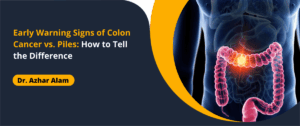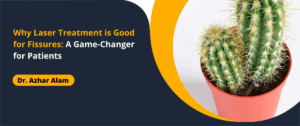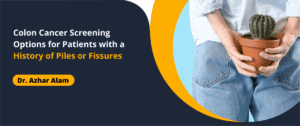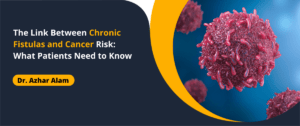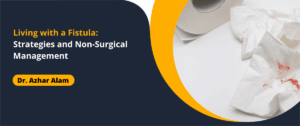
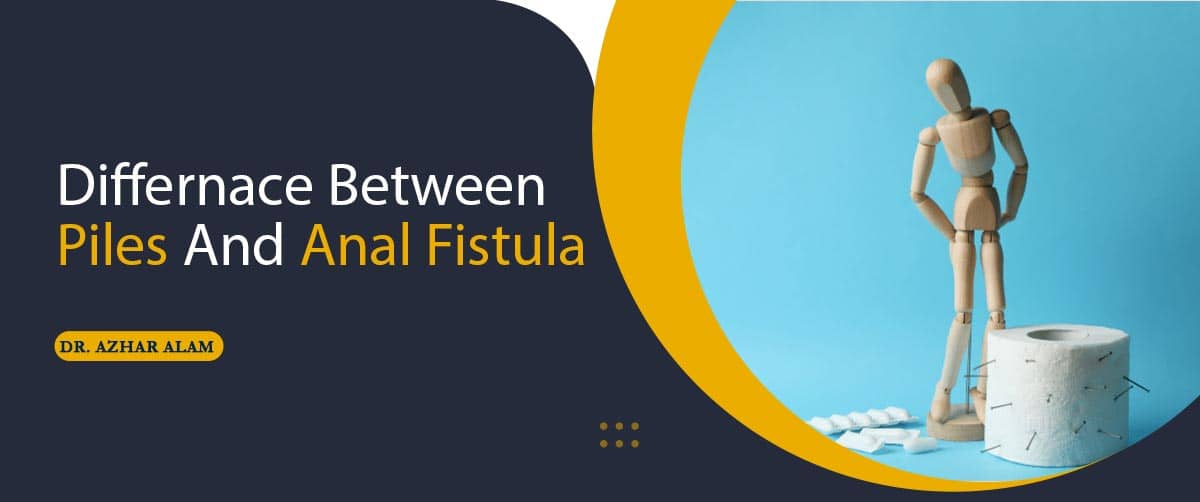
Difference between Piles & Anal Fistula
Piles are not defined by blood in the stool, pain in the bowel or discomfort in one’s anal area. These are the main symptoms for piles.
Anal fistula can also have similar symptoms. Many people don’t know that there are other anorectal conditions. This blog compares piles to anal fistula.
Differential and similarities between Anal Fistula and Piles
Anal canal inflammation and swelling can cause an anal fistula. The anal fistula is caused by an infection in the anal channel. Piles may be either external or internal. Anal Fistula can be internal or external.
Symptoms – The most common symptoms of piles include swelling and pain around the anal area. Anal fistula symptoms include pain, fever, and the discharge of pus or blood from your anal opening.
Discharge of Puss – In the case of piles, there is no discharge. You may find blood on the stool or toilet paper. An anal fistula is characterized by a watery, purulent, pus-like discharge that comes from the anal opening.
Sac– Piles have no opening. There are two openings on the ends of anal fistula. One is located around the anal opening.
Causes-Chronic or chronic cough, poor eating habits and a bad lifestyle can all lead to piles. Fistula can also be caused by obesity, Crohn’s disease, and the most common case of abscess. Pillows and anal fistula can be caused by factors such as constipation history or sitting for long periods of time.
Also Read: Fistula Recovery: What To Expect At Home
Difference between Fistula and Piles
Basis | Piles | Anal Fistula |
Definition | Chronic constipation can cause swelling of the blood vessels in your anal canal. | Fistula, also known as Anal Fistula, is a small opening in anal canal. It is a kind of cavity that is filled with pus. |
Symptoms | Pillows in the first stage are usually not noticeable because they are painless. However, in their later stages, there may be swelling, blood in stool, and soreness around the anal area. | This can also be a serious anorectal problem as the pus is constantly leaking from the anal region. |
Causes | Chronic cough, persistent constipation, and pregnancy. | People with Crohn’s disease are obese. They sit in one spot for long periods of time, and constipation. |
Prevention | Drinking liquids and eating a diet high in fiber are the best options. However, it is important to not put too much pressure on your stool when passing it. | The best way to prevent infections in the anal canal is to practice good hygiene habits when using the toilets. |
Prevention
Both in cases of Piles as well as anal Fistula, patients are advised to drink lots of fluids and water, and to eat a healthy, high fiber diet. This prevents the patient from putting extra pressure on the stool when passing it.
Passing a hard stool in these cases can prove painful and difficult. When using the washrooms, it is important that the patient maintains good hygiene. Infections with existing diseases can be exacerbated by unhygienic conditions.
Treatment
Piles can be treated with medication and healthy eating and lifestyle habits. The patient may not be aware that they have the disease because there are no symptoms at the beginning. When hemorrhoid size increases, symptoms begin to manifest in later stages.
Hemorrhoid must be treated surgically during the late stages of the disease. Anal fistula can be treated with medication if diagnosed early. If the diagnosis is not made early, the risk of infection in the anal can rise. Before surgery, MRI, Ultrasound or other tests can be used to determine the extent of the disease and its spread.
Is it possible that they are both located in the same location?
Anorectal diseases include piles and anal fistula. Both affect the anal or lower rectum. Are they found in the exact same area? But where are they located?
Hemorrhoids, or piles, are the swollen veins located in the lower part of the rectum. They are generally found in the anal area. Piles can either be internal or external.
The anal opening is generally 2-4 cm above the internal piles. The anal opening is just outside the external piles. They are located at the edge the anus. Internal piles are more common that the external ones. In all cases, the size of piles can vary.
Fistulas can occur in many parts or regions of the body. Fistulas are not only found in the anal region, unlike piles.
Fistula may also be found in other areas of the body, such as the neck, throat, colon, and the surface around. Anal fistula refers to an infected tunnel that runs between the anus skin and the perianal skin. This canal’s external opening is called the anal opening.
Hemorrhoids or piles
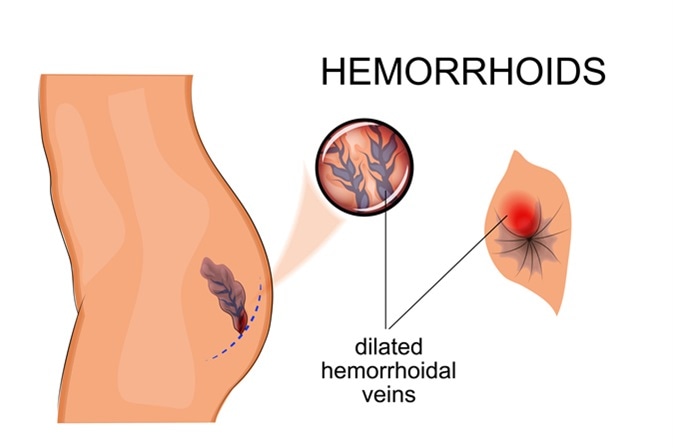
Hemorrhoids are also known by piles . This disease causes swelling of the blood vessels in your anal canal.
There are four stages to the disease. The person does not experience symptoms in the first stage. The anus’ inner lining is only slightly inflamed. At this stage, there are no visible symptoms.
The hemorrhoids grow in size during the second stage. The anal opening is enlarged by the lump when pressure is applied to it during bowel movements. After passing stool, the lump will return to its original position.
The third stage is when the lump returns using fingers, following the bowel movements.
The fourth stage is when the lump cannot be moved back in and remains outside. Hemorrhoid pains can cause severe pain in the patient’s legs and feet. The condition is not often recognized until later stages, when the lumps become larger and more painful.
Signs:-
- You can feel a hard lump around the anus.
- Red blood spots on the toilet paper and stool
- Itchy, red, swelling, and itchy around the anal area, particularly around the opening.
- In the latter stages of the disease, there is pain during bowel movements.
- Anal bleeding or discharge
- Infections in the or around the anal region.
- Fecal incontinence.
Pile-causes:-
- You can sit for hours on end every day.
- Chronic constipation or diarrhea.
- Pregnancy
- Spending too much time on the toilet.
- Lifting heavyweights
Treatment:-
Piles can be treated with medication, healthy eating habits and lifestyle changes. However, medication cannot be used to treat a lump that has grown in size.
It must be surgically removed. There are many options available to the patient, including injection, rubber band ligation and hemorrhoidectomy. The doctor will recommend which type of surgery is best for the patient. Laser treatment is the most efficient, safest and fastest way to eliminate piles.
Laser therapy is a permanent treatment for piles. The procedure is painless and takes approximately one hour. After the treatment, the patient is able to return home the next day. There is no risk of infection because there are no incisions or cuts.
This modern treatment provides instant relief for piles. Consult with the Best Piles Doctor in Kolkata.
Anal Fistula
Anal fistula refers to the infected tunnel that develops between the anus skin and the perianal. The fistula curves towards the anal opening.
Anal abscess is usually diagnosed later in the life of a person who has had anal abscess. Fistula can also be caused by other serious illnesses such as Crohn’s Disease or cancer. Fistula is a condition that affects obese people who sit a lot and don’t engage in physical activity.
Fistulas are more common in adults than they are in children. Perianal abscess patients are at high risk for developing anal fistula.
Signs:-
- Itching, pain, swelling, itching, irritation, or soreness of the skin around the anus and especially the anal opening.
- Blood discharge
- Painful bowel movements. Patients may experience pain when they urinate in the worst case.
- Fatigue and fever.
Foul-smelling discharge from the anal open
Fistula-causes:-
- Anal abscess was previously common.
- Crohn’s Disease
- Sexually Transmitted Diseases
- Trauma
- Tuberculosis
- Cancer
- Diverticulitis.
Treatment:-
Anal fistula can be treated in its early stages with medication and precautions in daily living. To get more information about the disease, doctors may recommend tests such as MRI, Endoscopy and Ultrasound.
The patient can then choose from a variety of surgical options to remove the fistula, including Fistulotomy or Advancement Rectal Flap. LIFT, Seton Placement, Muscle flap and Laser surgery.
Laser treatment is the most effective, safest and fastest way to treat fistula. Laser treatment is permanent for fistula. The treatment is painless and takes about an hour.
After treatment, the patient is able to return home the same day. There is no risk of infection because there are no incisions or cuts. The modern treatment for fistula is painless and quick. Consult with the Best Fistula Doctor in Kolkata.
Overview - Anal Fistula and Piles
Anorectal disorders can be characterized by blood or pus discharge, constipation and pain. Anorectal diseases are more common in those who eat poorly, live in an unhealthy lifestyle and don’t get enough fluids. These symptoms should not be ignored.
Before visiting a doctor, the patient should not take any medication or attempt home remedies. Anal canal diseases are serious. Do not ignore them. These diseases may also be a sign of a more serious disease such as Cancer. If you notice these symptoms, consult a doctor immediately.
These problems can be quickly relieved by pain-free laser therapy. There are no major surgical procedures, cuts or stitches involved. After the surgery, the patient can go home immediately. Do not waste time, make an appointment as soon as possible to relieve the pain and live a healthy lifestyle!
About Docor

Dr. Azhar Alam
MBBS (Honours), MRCS A (UK),
DNB General Surgery
FIAGES (Gastro Intestinal Surgery)
FMAS (Minimal Access Surgery),
MNAMS (New Delhi)
Consultant Gastrointestinal, Advanced Laparoscopic and Laser Surgeon
Assistant Professor of Surgery, KPC Medical College and Hospital
